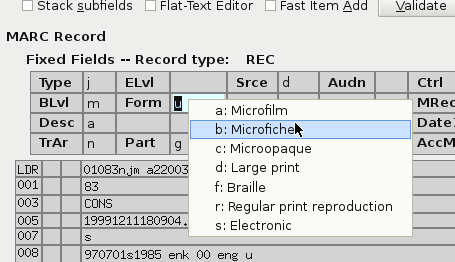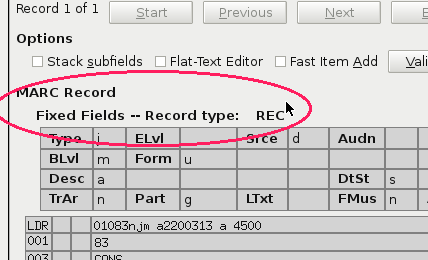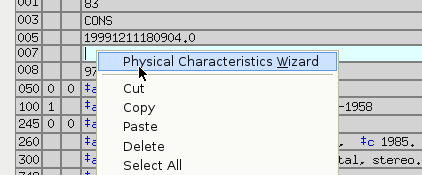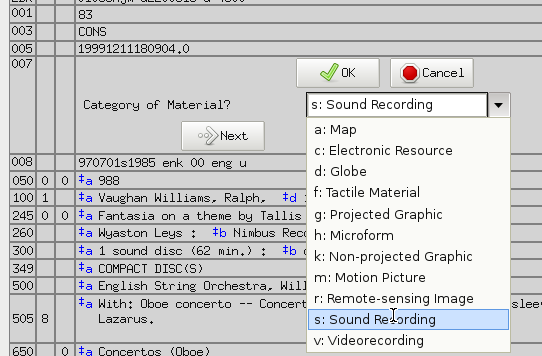1. Upgrade notes
1.1. OPAC
1.1.1. TPAC library pages
Evergreen 2.5 introduced the Library information URL library setting to associate a web page with a library. If set, this value was used as the target of the library link in the copy table on the record details page. However, the new default behavior is to link to the automatically generated TPAC library page, which in turn links to the external web site.
If you wish to maintain the previous behavior, you can set the Use external library information URL library setting to True.
1.1.2. Disable Autosuggest by Default
As described in https://bugs.launchpad.net/evergreen/+bug/1187993, the community is aware of ongoing accessibility issues caused through use of the autosuggest feature of the Evergreen catalog. The decision has been made to disable autosuggest by default for new installations. Existing sites are cautioned to take note of this change and decide for themselves whether to discontinue use.
It is possible to disable the autosuggest feature via a global flag. Look in Admin -> Server Administration -> Global Flags, find the OPAC: Show auto-completing suggestions dialog... setting, then edit and uncheck the Enabled box.
1.2. Miscellaneous
1.2.1. Removal of open-ils.ingest service
The open-ils.ingest service is no longer required, and has been removed.
You should update your opensrf.xml file to remove references to open-ils.ingest, and you may also wish to remove the OpenILS/Application/Ingest.pm file from your Perl @INC path.
In opensrf.xml, remove the entire <open-ils.ingest> element from the <apps> element, and remove <appname>open-ils.ingest</appname> from any <activeapps> elements where it is present.
If you have the perldoc command installed, you can use the following command to locate the path on disk of the Ingest.pm file, which is no longer required and can be removed:
perldoc -l OpenILS::Application::Ingest
1.2.2. Reporter view classic_current_circ dropped
As part of the DB upgrade, the reporter view "reporter.classic_current_circ" was dropped. If you previously installed this view from example.reporter-extension.sql, it will have to be re-installed by executing the "CREATE OR REPLACE VIEW reporter.classic_current_circ AS…" SQL once again from example.reporter-extension.sql.
2. New Features
2.1. Administration
2.1.1. Add granular settings for requiring staff initials for notes
There are now three separate library settings for controlling whether staff are required to input their initials when creating different types of notes. See new library settings below.
Any pre-existing library setting for requiring staff initials are preserved during the upgrade process. After upgrading, you may choose to change the set behavior for any of the three new settings.
New Library Settings
-
Require staff initials for entry/edit of patron standing penalties and messages. (ui.staff.require_initials.patron_standing_penalty)
-
Require staff initials for entry/edit of patron notes. (ui.staff.require_initials.patron_info_notes)
-
Require staff initials for entry/edit of copy notes. (ui.staff.require_initials.copy_notes)
2.2. Cataloging
2.2.1. Enhancements to Evergreen’s MARC Editor Concerning Fixed Fields
This work is a combination of two features. One provides suggested values in a right-click context menus for fixed field values based on the type of the record being edited. The other provides a wizard to help specifically with the Physical Characteristics of the record, i.e. the 007 field.
Right-Click Context Menus
Users will be able to right-click on the value control for fixed fields in the MARC Editor, and Evergreen will provide a menu from which the user can select a possible value. This will work for fixed fields where Evergreen already contains information from the Library of Congress’s MARC 21 standard.
Example:

Evergreen already comes loaded with information from the Library of Congress’s MARC 21 standard on possible values for some fixed fields.
The following table shows which fixed fields for which Record Types have values already loaded into Evergreen.
Fixed Field | Record Types
-------------+-----------------------------------
Audn | {BKS,COM,REC,SCO,SER,VIS}
BLvl | {BKS,COM,MAP,MIX,REC,SCO,SER,VIS}
Form | {BKS,MAP,MIX,REC,SCO,SER,VIS}
Lang | {BKS,COM,MAP,MIX,REC,SCO,SER,VIS}
LitF | {BKS}
Type | {BKS,COM,MAP,MIX,REC,SCO,SER,VIS}
A Record Type is itself a combination of the Type of Record (fixed field name: Type) and Bibliographic Level (fixed field name: BLvl) elements of the MARC leader (positions 06 and 07 respectively). You can see a record’s Record Type in the MARC Editor as shown in this screenshot:
Record Type:

A user may add values to these fixed fields as well as to other fixed fields through the MARC Coded Value Maps interface found under the Admin → Server Administration menu in the staff client. These are grouped by Record Attribute Types (a superset of fixed fields) which have labels such as Alph, Biog, Videorecording format, and Language.
From LOC Fixed Fields documentation, Alph is Original alphabet or script of title, Biog is Biography, Videorecording format is from the 007 field, Language is positions 35-37 of the 008, and so on. Other Record Attribute Types such as Author are, of course, not fixed fields at all.
When users add new values here, the right-click context menus of the fixed fields in the MARC Editor will include those values.
All values added for any fixed field in the Coded Value Map will display for any Record Type that uses that fixed field.
Users of the MARC Editor always retain the option of leaving a fixed field blank, entering the special values # or |, or entering a value not provided by the right-click context menu.
Physical Characteristics Wizard
By right-clicking on an existing or new 007 field in the MARC Editor, users will be able to enter a wizard that leads them step-by-step through the positions in that 007 field, telling them the significance of the current position and providing a drop-down list of possible values.
Launching the Physical Characteristics Wizard:

Choosing the Category of Material:

Choosing a value for a later position:

2.2.2. marc_export script replacement
The /openils/bin/marc_export script is completely rewritten. This new version accepts all of the same command line options as the old version as well as some new options.
The rewritten marc_export talks directly to your Evergreen database and is a great deal faster than the previous version. Because the new script talks directly to the database, it needs to know how to connect. To facilitate this, a new option, --store, was added that allows the user to specify one of three Evergreen storage backends to use when exporting records. The valid choices are reporter, cstore, or storage. The default of reporter should work in most cases, but if you do have a separate reporter database and you know you want to talk directly to your main production database, then you will probably want to choose either cstore or storage.
In addition to the --store option, a --since option is also added so that you can specify output of an update file of records changed, added, and/or deleted since the given date. The --since option uses a fairly flexible date parser and can accept a wide range of date formats including ISO 8601, man common date formats such as M/D/Y (common in the US) or D/Mon/Y (with the first 3 characters or more of the month spelled out), as well as several less common date formats. Special date strings such as yesterday, today, yesterday week, and today week are also supported. For more information see the VALID DATE FORMATS section of the Date::Manip::Date man page. Available online here:
There is one final difference between the new script and the old marc_export. The new script does not output progress as it executes. Many of the statistics that the script reported are not readily available to the new script. It was deemed better to just not output any progress rather than to output something different from the old program. If your scripts parse the output from marc_export, they will need to modified not to expect any.
2.3. Circulation
2.3.1. Lost Item Billing: New Min/Max Price Settings
When an item is marked lost, the user is typically billed for the item. In Evergreen, they can either be charged the amount recorded in the item object, or if that value is blank (or zero), charged a default price (controlled by settings).
In addition to these existing settings, now we can accommodate a range of prices by saying the patron should be billed at least X and not more than Y. This also allows you to effectively set a fixed price for all lost items by setting min and max to the same amount.
New Org Unit Settings
-
Minimum Item Price: circ.min_item_price
-
Maximum Item Price: circ.max_item_price
New Permissions
-
UPDATE_ORG_UNIT_SETTING.circ.min_item_price
-
UPDATE_ORG_UNIT_SETTING.circ.max_item_price
2.3.2. User Editor: "Update Expire Date" button
A new button labeled "Update Expire Date" is added in the user editor next to expire date field. This button can be used to re-calculate the user’s expire date based on the current profile’s permission interval and today’s date.
This is similar to how the expire date is populated when creating a new user, or when changing the profile group.
This button simplifies the process of "renewing" a user, by eliminating the requirement that staff manually enter a new expire date.
A button is used here so that the updating of the expire date remains an intentional process, not one that happens upon any edit.
2.4. OPAC
2.4.1. Composite Record Attributes
With this feature we create an abstraction on top of the Record Attribute infrastructure to allow the aggregation of multiple, cross-Attribute values under a single search filter value, accessible through new, dynamic filters.
Each QueryParser filter will be created by the addition of a Composite Record Attribute Definition. For instance, one may wish to create a Composite Record Attribute Definition for an abstract "Item Type" interface component that uses information from the item_type, vr_format, bib_level and item_form Record Attribute Definitions, with each Composite Record Attribute Value having a different combination of Record Attribute Values from some or all of these Record Attribute Definitions. In this way, as single interface component might be presented as a dropdown with options such as "All Books", "All video recordings", "DVDs", "VHS Tapes", "E-Books", "Audio Books" and "Large Print Books". Of particular note are the "DVDs" and "VHS Tapes" entries, which include information from Record Attribute Definitions completely separate from the others. Additionally, the Composite Record Attribute Values defined by this Composite Record Attribute Definition can be used to drive behavioral logic, such as alternate icon display or link generation, in upgrade-friendly template adjustments.
Included in this development is a replacement for the single-attribute Format filter supplied for basic search. Instead, a Composite Attribute is used to combine the values from Item Type, Item Form and Videorecording Format in various ways that provide a more patron-friendly set of choices.
This new Format filter can be adjusted, or even replaced with a completely local one, through configuration and without template adjustment.
2.4.2. Located URI visibility options
Before this, Evergreen restricted the visibility of bibliographic records that make use of Located URIs in a way that attempts to model licensing restrictions.
There now exists a global flag to allow sites the option of changing the behaviour of Located URIs so that they act in a way analogous to copies for visibility testing. When the opac.located_uri.act_as_copy global flag is enabled, Located URIs will cause their containing bib records to become visible in searches where the URI is in scope to either ancestors of the search library, as before, or descendents of the search library, as copies do. As before, if a preferred library is supplied by the user, it is added to the list of visible org units to check.
Additionally, while the underlying UnAPI and supporting code was capable of providing a reasonable and logical sort order for the Located URIs when embedded as XML holdings elements, the client-facing UnAPI method was not making use of that. It now does, and uses the same sorting algorithm as is used for copies.
2.4.3. Multi-valued Record Attributes and Controlled Record Attributes
Having identified common use cases and reasonable restrictions that can be placed on the feature set, we have extended the Record Attribute infrastructure to support both the extraction and storage of all instances of a defined Attribute found within a bibliographic record, as well as provide new and more powerful indexing of existing data, in several ways.
Record Attributes can now be defined by configuration as either single-valued or multi-valued. For any Attribute configured as single-valued, only the first value extracted from a record will be stored. This configuration parameter and restriction is in place to support potential query optimizations based on foreknowledge of whether a given Attribute is multi- valued or not.
Record Attributes will be defined by configuration as either controlled or uncontrolled. A controlled Record Attribute is one that has entries in the Coded Value Map infrastructure specifying the valid values the record may carry for this attribute. If defined as a controlled Attribute, any unknown values extracted from a record will be ignored. Uncontrolled Attributes, however, may contain any value. This configuration parameter and restriction also supports potential query optimization.
We store uncontrolled attribute values in a new table with a monotonically decreasing ID sequence, separating it from controlled values, reducing storage requirements by retaining only unique values, and making lookup faster.
Restrictions
-
A Record Attribute’s values must match Coded Value Map entries if it is to be a Controlled Attribute. Coded Value Map control is indicated by a new "controlled" boolean on the config.record_attr_definition table.
-
Record Attributes must "opt in" to multi-valued-ness. Record Attributes will opt in via a new "multi" boolean on config.record_attr_definition; this restriction enforces site config requirements by being explicit about the definition of "multi" fields.
-
If controlled but not opt’d in to multi-mode, only the first value will be recorded but the new search mechanism will be used.
-
Only single-valued Record Attributes will be available for use by the system as Sort Axes.
-
Only controlled Record Attributes will be available for use by the TPAC as dynamically generated filter UI components, such as filter dropdowns or multi-selects.
New External Dependency
This new feature requires the addition of the intarray extension to Postgres. This is a stock extension available on most linux distributions via the same package as the already-required plperl extension.
2.4.4. Restore OpenSearch Support
Restore previously held functionality from JSPAC to support OpenSearch in TPAC. This allows users to easily add the Evergreen search engine to their browser’s built-in set of search engines.
2.4.5. Accepting payments with Stripe
Stripe is a payment processing service that lets sites take credit card payments without payment card information ever touching the sites' own servers.
|
Note
|
Using Stripe as a payment processor means that clients must have Javascript enabled in order to submit fine payments through your OPAC. |
Library Settings
The following settings need to be set at the appropriate org level for sites wanting to use Stripe.
-
"Allow Credit Card Payments" (should be true)
credit.payments.allow
-
"Enable Stripe payments" (should be true)
credit.processor.stripe.enabled
-
"Stripe publishable key" (value provided by Stripe)
credit.processor.stripe.pubkey
-
"Stripe secret key" (value provided by Stripe)
credit.processor.stripe.secretkey
-
"Name default credit processor" (should be Stripe)
credit.processor.default
2.4.6. TPAC library pages
This feature adds one web page per library in the system to the TPAC at http://hostname/eg/opac/library/<SHORTNAME>; and http://hostname/eg/opac/library/<ID>;. The pages publish the following information from Evergreen (if available):
-
Name of the library
-
Link to the lbrary web site (from Library Information URL library setting)
-
Opening hours
-
Email address
-
Phone number
-
Mailing address
-
Link to parent library (if applicable)
Library pages are linked from the copy table on the record details page.
Structured data
The library web pages publish schema.org structured data, which can enable search engines and other systems to better understand your libraries and their resources.
2.4.7. TPAC Metarecord Search and Holds
This feature adds support for searching and placing holds against metarecords.
Metarecord Searching
In the top search bar and in the advanced search page, there is a new search modifier labeled "Group Formats and Editions". When selected, searches are performed against metarecords and metarecords are shown in the results list.
For each metarecord, format icons for all constituent records are shown. When a use clicks on a metarecord, if the metarecord has multiple constituent records, the user is taken to the constituent records list. Similarly, when a metarecord only has one constituent record, the user is directed to the record detail page for the constituent record.
Metarecord Holds
Clicking the place hold link from the metarecord results page shows the available formats and languages for the metarecord, allowing the user to limit the scope of the hold. Non-metarecord holds now get a new "Advanced Holds Options" link which allows user to promote a title hold to a metarecord hold, thus providing access to the formats / editions selector, before the hold is placed.
In the My Account holds list, icons for all selected formats are displayed in the Format columns for the hold. When editing a metarecord hold, users may modify the desired formats and languages.
Configuration
Admins may disable this feature by un-commenting the "metarecord.disabled" attribute in config.tt2
2.4.8. Web Content Accessibility Guidelines (WCAG) Compliance
To make the catalog more accessible to users with a range of disabilities, including blindness and low vision, the catalog has been revised to better comply with the Web Content Accessibility Guidelines (WCAG) 2.0. These revisions target level "AA" of compliance.
For more information on WCAG, see http://www.w3.org/WAI/intro/wcag
3. Acknowledgments
The Evergreen project would like to acknowledge the following organizations who commissioned developments in this release of Evergreen:
-
Butler Public Library, IN, USA
-
British Columbia Libraries Cooperative
-
Carnegie Public Library of Steuben County, IN, USA
-
Centerville-Center Township Public Library, IN, USA
-
Flora Public Library, IN, USA
-
Hagerstown - Jefferson Township Library, IN, USA
-
Howe Library, Hanover, NH, USA
-
Massachusetts Library Network Cooperative
-
Newton County Public Library, IN, USA
-
Noble County Public Library, IN, USA
-
Natural Resources Canada
-
North of Boston Library Exchange
-
Perry County Public Library, IN, USA
-
Plainfield-Guilford Township Public Library, IN, USA
-
Rodgers Memorial Library, Hudson, NH, USA
-
Statistics Canada
-
Union County Public Library, IN, USA
-
Westfield Washington Public Library, IN, USA
We would also like to thank the following individuals who contributed code and documentations patches to this release of Evergreen:
-
Jason Boyer
-
Galen Charlton
-
Mark Cooper
-
Bill Erickson
-
Jason Etheridge
-
Lebbeous Fogle-Weekley
-
Jeff Godin
-
Pasi Kallinen
-
Mike Rylander
-
Dan Scott
-
Chris Sharp
-
Ben Shum
-
Remington Steed
-
Jason Stephenson
-
Yamil Suarez
-
Elliot Voris
-
Dan Wells
We also thank the following organizations whose employees contributed patches:
-
Berklee College of Music
-
Bibliomation
-
Calvin College
-
Equinox Software, Inc.
-
Georgia Public Library Service
-
Indiana State Library
-
Laurentian University
-
Merrimack Valley Library Consortium
-
Pohjois-Karjalan Tietotekniikkakeskus Oy
-
Saint Louis Christian College
-
Traverse Area District Library
We regret any omissions. If a contributor has been inadvertantly missed, please open a bug at http://bugs.launchpad.net/evergreen/ with a correction.